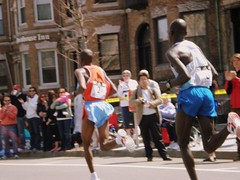One of your practice goals should be to be able to make sense of other people's movement patterns. Learning how to watch someone move, and see what's going on, is going to give you really valuable information that you can then apply to your own practice.
In the following video clip, I demonstrate two different gait patterns, with different arm swings. If you can start to see how the arm swing differs between the two, you'll start to gain some valuable insight into how to assess and correct your own movement imbalances.
Watch the clip and then we'll look at some of the implications:
As I said at the beginning of the clip, your body adapts to postural changes instantaneously to find the most efficient way of dissipating force that comes into your skeletal structure. This principle was first explained to me by Dr. Eric Cobb, creator of Z Health Performance.
When you can see excessive (or deficient) movement in someone's whole-body pattern, you can pretty reliably draw the conclusion that they need some isolated movement tune-up.
But, the site of the abnormal movement is not the problem area.
Always remember that principle. Was there something wrong with my left arm in the video clip? No, it started swinging more because the right arm was restricted. We changed the right arm and created excessive swing in the left.
Now, there is a lot more to be said for how you begin to see the connections and determine what needs to move more or less to make the whole body move more efficiently. For now, though, I want you to try a little experiment.
Field Test Your Ability to See
 Brookline Tai Chi is located at mile 23 of the Boston Marathon. People run up and down Beacon Street all day long. As we were working on our ability to see these patterns, a friend and I would sit on the front steps of Brookline Tai Chi to watch runners and walkers come and go.
Brookline Tai Chi is located at mile 23 of the Boston Marathon. People run up and down Beacon Street all day long. As we were working on our ability to see these patterns, a friend and I would sit on the front steps of Brookline Tai Chi to watch runners and walkers come and go.
Find a good spot with lots of running traffic and look for:
- Differences in swing between left and right arms from behind
- How high each foot comes up behind the body -- can you see the sole of the shoe?
- Torso rotation -- is it more pronounced to one side?
- Excessive head movement in any particular direction
- "Stirring" with the arm -- making a circle out to the side instead of coming straight back
- "Loops" in the lower leg -- circles instead of straight up and down movement
The challenge with seeing these patterns is that we very easily integrate this information and experience is as "someone running." We don't stop to consciously parse the different parts of their movement. For the most part, it's a good thing that we take in chunks of information, instead of individual pieces. Think of how daunting it would be to have to record each data point and consciously put it together. You'd never make it down the street!
But, if you want to really hone your ability to see, correct, and improve movement patterns, you have to train to break the patterns back down again.
Let me know how it goes!

Share this post
Twitter
Google+
Facebook
Reddit
LinkedIn
StumbleUpon
Pinterest
Email